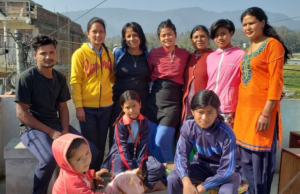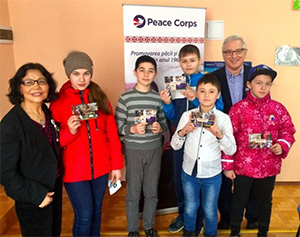David Jarmul (Moldova) “When COVID-19 Forced Peace Corps Volunteers to Evacuate”
How Volunteers over 50 learned the news and are feeling about it now
By David Jarmul (Moldova 2016-18)
nextavenue.com August 14, 2020

Kamana Mathur, center, with her host family in Panauti, Nepal
To do something meaningful
Kamana Mathur (Nepal), who’s in her early 60s, had just arrived at her Peace Corps post in Nepal shortly before the end of her training when she was told she needed to return home due to the COVID-19 pandemic. For the first time in its history, the Peace Corps was evacuating its volunteers worldwide.
“I was busy chatting with my host family,” Mathur recalled. “Then my colleague called and told me we had to leave. I said, ‘You know, I just sat down to lunch.’”
Mathur had left her federal job in Hawaii, she said, “to reinvent myself to do something really meaningful at this point in my life.” During her Peace Corps training in the Himalayas, she’d studied the local language and culture, used a squat toilet and taken cold showers. Now, instead of beginning her job teaching English to middle school students, she was about to board a plane home.
Crying after the evacuation news

Karen Jean Hunt gathers with some of her students in Kotu, Ethiopia
Karen Jean Hunt (Ethiopia), 64, had to board a plane, too, along with fellow Peace Corps volunteers and trainees leaving several African countries. “People were crying when they came into Addis [Ababa, Ethiopia’s capital],” she said. “I was thinking, ‘When am I going to see these people again when I get back to the States, and what are the States going to be like in a pandemic?”
“Part of me is back, but not really back.”
Hunt, a former university archivist who’d been teaching in Ethiopia, worried about her job prospects in America during the pandemic.
“Who’s going to hire someone who’s older? You’re coming back to an employment nightmare,” Hunt said. (She has since found work with AmeriCorps, the federal service program, helping parents and teachers in Sitka, Alaska cope with the pandemic.)
“I wanted to serve [in the Peace Corps] and I had a time frame in my head,” said Hunt. “Part of me is back, but not really back.”
What the Peace Corps director said
Jody Olsen, the Peace Corps director and a former Peace Corps volunteer, called this “the most difficult decision” she ever made.
Younger Americans have comprised most of the Peace Corps volunteers since President Kennedy launched the agency in 1961. But older volunteers serve, too, bringing their special perspective to communities across the developing world.
While Peace Corps volunteers typically get three months of in-country training and then take on two years of service, which some extend, there’s also a Peace Corps Response program that sends experienced professionals to shorter-term assignments. Volunteers over 50 accounted for roughly 3% of the two-year volunteers recently, but as much as 30% of the Response program.
The pandemic evacuation has affected not only volunteers and trainees in the field but also those who expected to join them soon.
Approximately 7,000 Peace Corps volunteers and trainees were serving in 61 countries when the agency decided in mid-March to suspend its global operations.
It even affected volunteers who hadn’t left the U.S. yet
Paula McGurn Snyder, 62, had been accepted to serve as a community economic development volunteer in Namibia and was getting ready to leave her Pennsylvania home to start in the spring. She got the bad news just one day before her planned going away party from her job running two rural senior centers.
Snyder said she was “very, very, very lucky” to keep her job, but says “it’s like a dream that didn’t happen. . . I feel like I’m not where I’m supposed to be.”
Janet Smalley, 58, a former Marriott executive, said she’d been looking into joining the Peace Corps for probably 15 years when she finally decided to apply. After a long medical clearance process, Smalley was approved to depart in April for Georgia, in Eastern Europe.
“Once I saw what was happening with COVID, I was pretty sure we wouldn’t go,” Smalley said.
She was right. “It was very disappointing to have gotten through all that. I’m really interested in giving back to other people,” Smalley said.
Now living with her sister and working as a community volunteer near Charlottesville, Va., Smalley is unsure whether to wait until the Peace Corps allows volunteers back or to move on with her life.
“We’ll see how it goes,” she said.
The Peace Corps’ plans for older Volunteers during COVID-19
The Peace Corps has released a statement saying it will return volunteers to service “only when confident that it can be done as safely as possible and does not put the citizens of our host countries, our Volunteers, and our staff at increased risk of COVID-19.”
The agency’s statement added that the Peace Corps will “not exclude healthy applicants because they are older” but will be guided by Centers for Disease Control and Prevention (CDC) data, which states “the risk for severe illness from COVID-19 increases with age.”
All Peace Corps applicants will be given an “individualized medical clearance assessment,” based on their current state of health, CDC data concerning risk factors for severe COVID-19 illness and host countries’ health resources and capabilities.
Peace Corps applicants previously cleared for service have been told their medical information will need to be reviewed again, in part to “to take into consideration your risk of developing severe symptoms of COVID-19.”
The bottom line: “The Peace Corps has not established an age limit on service,” according to the agency, but its medical review process is likely to become even more rigorous.
Citing “the skills, professionalism, and knowledge” of older Americans, the Peace Corps says it plans to invest in recruitment strategies to engage more of them in the coming fiscal year.
Prospects for life going forward
Older Peace Corps Volunteers and those who’d planned to serve are now facing the realities of pandemic America.
“Hopefully, they’ve learned how to navigate life’s ups and downs,” said Nicole Brule, a clinical psychologist in Eugene, Ore. who was evacuated as a Peace Corps volunteer in Lesotho in 1999 after a regional conflict broke out there.
Returning volunteers need months or more than a year to readjust under normal circumstances, Brule noted. But current circumstances are anything but normal.
“They are coming back to a world and a country that are a total mess,” Brule said.
In 2005, Brule surveyed 361 returned Peace Corps volunteers, and most said they found readjustment harder than they expected. Those who experienced a crisis had an even tougher time.
“Based on the research, this [current evacuees] group is in for a rough transition,” Brule said.
Hunt, who is working through her transition, hopes older Americans will continue serving in the Peace Corps in the future.
“If Peace Corps is something that you’re passionate about and always wanted to do, you have to give it a try,” she said.
Snyder agreed. “I was inspired to join the Peace Corps out of a deep desire to serve my country as an ambassador of peace and friendship,” she said. “Adults over fifty are bubbling with life experience and skills. We have a lot to offer and the Peace Corps needs us.”
•

David and Champa with students in Moldova
Author David Jarmul served twice as a Peace Corps volunteer, first in Nepal from 1977 to 1979, and then with his wife, Champa, in Moldova from 2016 to 2018. David describes his service in Moldova in his new book, Not Exactly Retired: A Life-Changing Journey on the Road and in the Peace Corps.
No comments yet.
Add your comment